I spend a lot of time paying attention to threats to the organisms that live in the desert, and what with all the environmental bad news available online these days that can be pretty damned depressing. This past weekend, though, I was reminded that there is actually hope for the future. Centuries from now we may well find that desert plants, especially those that now live within a day’s drive of Los Angeles, have a vital role to play in making yet-undiscovered planets habitable.
I was reminded of this while re-watching a set of documentary films describing the terraforming of an entire complex system full of dozens of more or less habitable planets, in many cases using entire vegetative suites once native to the California desert. I’ve gone back and taken some screenshots of these films to illustrate some of the ways in which the terraformers used desert plants, and they — along with discussion of the terraformed vegetation –are below the fold.
Here we see a typical planet in the system, unnamed as far as I could tell from the documentaries, with a classic Neo-Mojavean vegetative scheme. Joshua trees and what would appear to be a sparse understory of Ambrosia dumosa are clearly well on their way to stabilizing the planet’s soil, and it’s obvious from the unsuited figures in mid-foreground that they’ve done a good job of oxygenating the atmosphere as well.
On planets with a relatively low partial pressure of water vapor, the advantage of desert plants is pretty obvious. If that blurry low shrub is indeed Ambrosia dumosa, a.k.a. burrofat, it’s a good coice: it’s one of those plants that uses the efficient, water-conserving C4 photosynthesis which allows plants to keep their stomata closed during the day. The Joshua tree is a C3 plant, but it’s adapted to grow more quickly in cooler temperatures, which sidesteps some of the need to conserve water. C4 plants are quite eficient at sequestering carbon, and their use on this planet suggests its initial condition may have been a Venus-like greenhouse planet.
Absence of dark desert pavement on the rocks indicates that the granite boulders are actively exfoliating, not giving the slow patina a chance to develop. This implies that the soil in the area should be pretty fertile due to decomposed granite, giving us hope for long-term survival of the desert plants being used here.
This screen capture from a later visit to the same unnamed planet shows that the terraformers here didn’t limit their repertoire to Joshua trees and burrofat. That’s quite clearly a plain of creosote bush (Larrea tridentata) in the background, with what appears to be something very like a row of cottonwoods just below the horizon, possibly a biological component of a sewage treatment facility.
Other, somewhat less arid planets in the system seem to have been designed using a mix of desert plants and species from the California chaparral biome. In this screen capture from a visit to a planet the documentary series refers to as “Whitefall,” the light vertical stripes between the two people in the foreground are dead flower stalks of Hesperoyucca whipplei, a rosette succulent very common in California’s coastal mountains which bears the unfortunate-for-this-venue common name of Our Lord’s Candle. There’s what looks to be a healthy clump of chamise, Adenostoma fasciculatum, near the male figure’s shoulder, and the grayish rounded shrubs in the background may well be a mix of chamise and a few Californian salvias. The abundant brown vegetation suggests this planet has a strongly seasonal rainfall pattern. It also suggests that the planet’s vegetation may well be managed with periodic wildfires, a likely strategy for planets whose atmospheric carbon balance needs constant fine-tuning. Perhaps this planet’s oceans were seeded with a too-efficient strain of reef-forming coral that threatens to remove too much carbon from the atmosphere. Hard to say from the limited footage we have.
Here’s a much closer view of a Hesperoyucca flower stalk, emerging into the frame from lower right.
And a live, and in fact exuberant, rosette of Hesperoyucca peeking out from behind the figure in the center. The view past the rosette is of a dry, steep-sided canyon filled with alluvium, which indicates a tectonically active planet whose ranges are rising faster than Whitefall’s seasonal storms can erode them.
One last screen capture from the series, from another planet that has no mention of a name I could find:
Again, we see a crew of terraformers has opted for Joshua trees as a canopy species, with what looks like creosote bush as an understory.
It may be that the terraformers’ choices of vegetation reflect some degree of fashion as well as functionality, in much the same way that settlers attempted to “Europiform” the perfectly well-vegetated North American and Australian continents as a way of making themselves more comfortable in a seemingly exotic landscape. That might account for the prevalence of Californian aridland vegetation over, say, similarly adapted South African species — though I’m given to understand some consider Australian flora suitable for pressure-dome greenhouse settings.
The one thing I can’t figure out, though, is the presence of California junipers — the low-growing, dark green shrubs — in the unrelated bit of reportage from an uncharted planet embedded below. How did the same species develop both on Earth and on this distant, poorly documented planet? Convergent evolution must be the reason, though a less skeptical person might be tempted to suggest some kind of California desert panspermia as an answer.

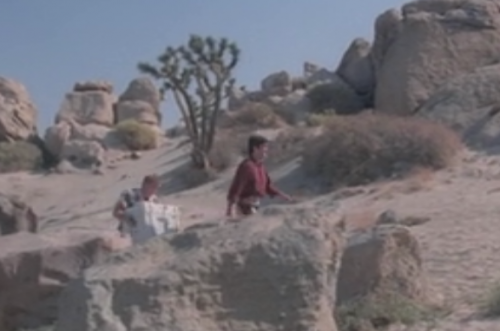
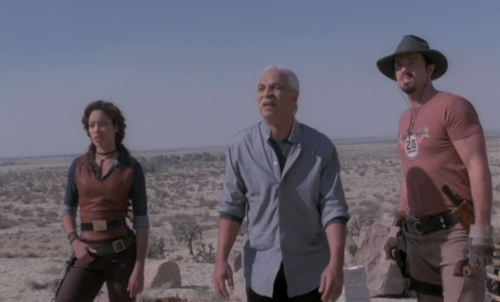

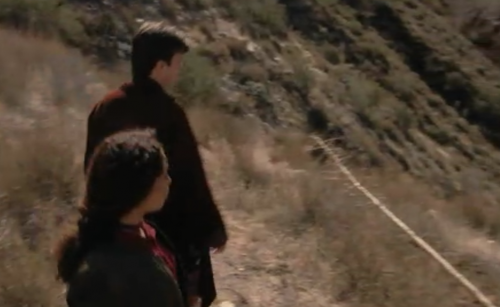
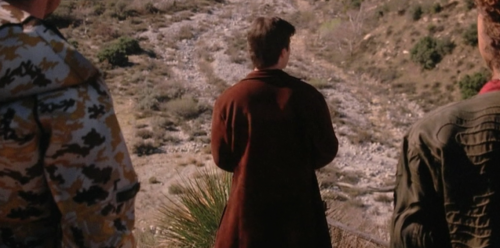
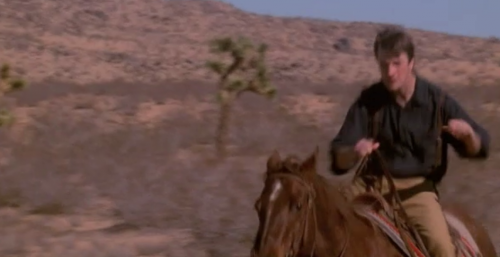

As numerous documentaries have, uh, documented, all exo-planets look exactly like the desert country immediately east of Los Angeles.
Paul Muad’dib describes the principal vegetation found on Arakkis. The Fremen use it to successfully terraform the planet in a few generations.
Actually, Pierce, as we’ve seen from Star Trek TNG, a number of exoplanets strongly resemble the Hollywood Hills.
In the last example, it’s not just the California junipers that need explanation. There’s also that hunk of Bambusoideae….
Could have gone straight into Accretionary Wedge 49.
So does South Korea. And Hazard County, Georgia.
And strange pets from desert planets, oddly, strongly resemble banana slugs.
In plexiglas pocketbooks.
I hope further study will be done on how rockslides of large styrofoam / papier-mache boulders play a role in these ecosystems.
and in the stargate franchise it all looks like Canadian woods.
uncle frogy
There’s thousands of planets in this universe that all look remarkably like Welsh quarries. True fact, that.
Amphiox’s comment confused me until I realized the YouTube embed had gone wrong. Clip I intended is there now. Which is good because the previous one had no junipers in it. Scrub oaks, but no junipers.
I hadn’t realized I’d been watching so many educational films my whole life! At last I have a reply to those who believe I am reading/watching some science fiction claptrap with no practical use in real life – I am, in fact, researching terraforming! Thank you, Chris.
Recalibrating various meters around here. Still need more data pertaining to new host life-form.
I think it’s dependent on the company/nation doing the terraforming; some seem to prefer the “Welsh Quarry” model.
Hmm. Do you think these same plants could be used to make Los Angeles habitable?
Very interesting, but it would be even better if you could fit giant sandworms into it somewhere.
Perhaps there is a hitherto unrecognized fundamental law of evolutionary processes, which we here on earth have not recognized simply because of our limited perspective.
Thus, just as every intelligent tool using species in the universe will always develop, among their various foodstuffs, the dish which on earth is known as “Swedish meatballs”, every terran-class habitable planet will invariably evolve, somewhere among its diverse ecologies, the climax community known as earth as “Californian desert flora”.
The Californian Juniper is the secret purpose of the universe.
I seem to recall an invasive species as well from the documentary, some Reaveranthropus Mirandis if I’m correct.
Nasty little things.
And here I was sure the “Whitefall” in question was a moon. Hm, I’ll have to go re-watch that documentary to be certain…
@tomfrog, oops! you’ve got at least the genus wrong… They finally changed it in 2005 in light of newly-confirmed phylogenetic information.
Here we also see the only known example of Herous Cantonii.
This documentary is brilliant.
I tried to grow one or 2 of those plants a few years ago but they died. Presumably the conditions on alien worlds will be less inhospitable than my living room in Connecticut
Rod
If you are interested in the process of terraforming a planet, I highly recommend Kim Stanley Robinson’s Mars trilogy.
@ ibbica, #20: To be frank I know so little about the binomial nomenclature, I was just happy to make something sounding scienty and à propos.
So, were they Homo Mirandis or something? Or am I still way off? :)
Some fall into other categories, such as the forests of British Columbia and gravel quarries in Wales.
The ecology notwithstanding, how exactly does that many habitable planets all manage to fit into the habitable zone of a sun-like star without the resulting gravitational chaos resulting in multiple collisions, ejections from the system, or flinging into the star?
Unless they’re all moons of a single gas giant?
I’ll just go fix myself a jynnin’tonnix now.
After a day in the office dealing with “normal” people, this post and its comments has made me ridiculously smiley :)
Pass me that bottle of Janx Spirit, Rey Fox.
Clare
I would just like to point out that the California Desert Panspermia hypothesis was expanded upon and supported by a later documentary episode http://en.wikipedia.org/wiki/The_Chase_(Star_Trek:_The_Next_Generation)
Interesting. I am familiar with sever collections of documentaries on un-terraformed extra solar worlds. Those seem to indicate there are at least two classes of natural, habitable extra solar worlds: those worlds that resemble the rain forests near Vancouver and those that resemble English quarries.
@Amphiox: I strongly, strongly recommend against investigating the stellar cartography explored in that particularly Documentary. The film-making and human-interest sections are much more informative than the parts on astronomy… which will make your brain come out your ears if you have any interest in astrophysics whatsoever.
hmmm. The planet in that last clip looked familiar so I searched the master database and found evidence of other visitors:
limk
link
link
Pierce @ 1 —
Just north of L.A. even more so. The Antelope Valley has stood in for most of the Southwest as well as the majority of desert planets ever put to film. There is the occasional wasted take when a meth lab explodes in the background, but yeah.
Not all exo-planets look like “the desert country east of Los Angeles.” Most worlds connected by Stargates appear to have been terraformed with the forests outside of Vancouver.
@34 —
In all fairness, the Pacific coast of North America is ridiculously excessively-endowed from the biodiversity perspective. Is it really such a surprise that two locations along that coast (BC and the western fringe of the Mojave desert) end up standing in for such a range of environments? (Add in the area in-between and it gets to be an even more insane percentage of screen time…the Ewoks live in the Coast Redwood-dominated sections of the California central coast, for instance…)
Indeed, growing up in southern Oregon I had many opportunities to visit Endor.
No planet would feel like home without the smell of creosote bushes after a rainstorm. Maybe that’s just me…..
I can tell you from experience that if one of your ship’s crew rolls down a bank covered in ice plant they’ll never get the stains out of their jumper. I’m not sure what the juice will do to a communicator.